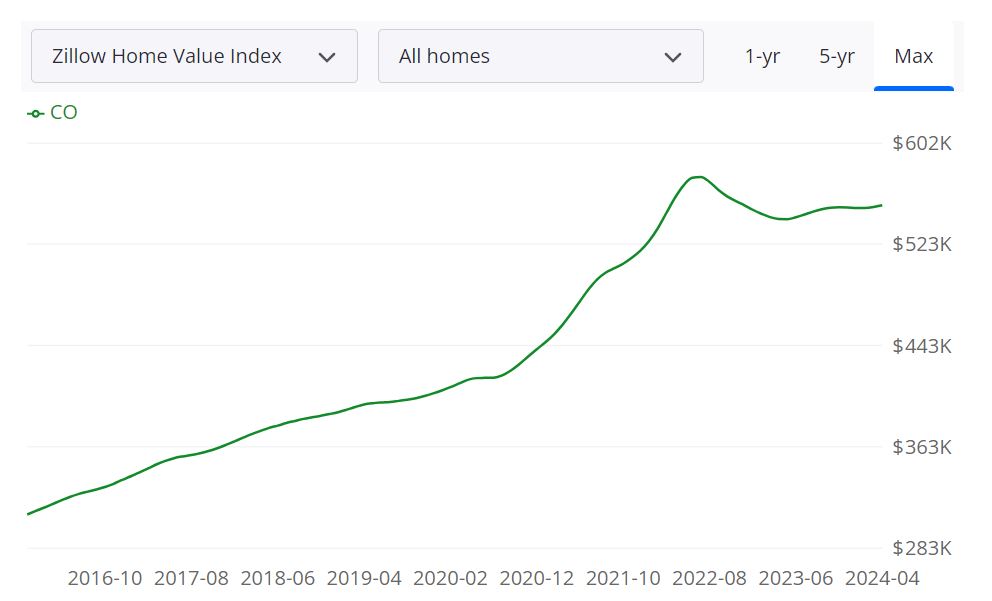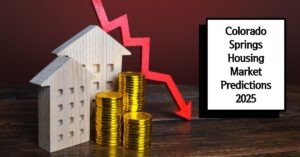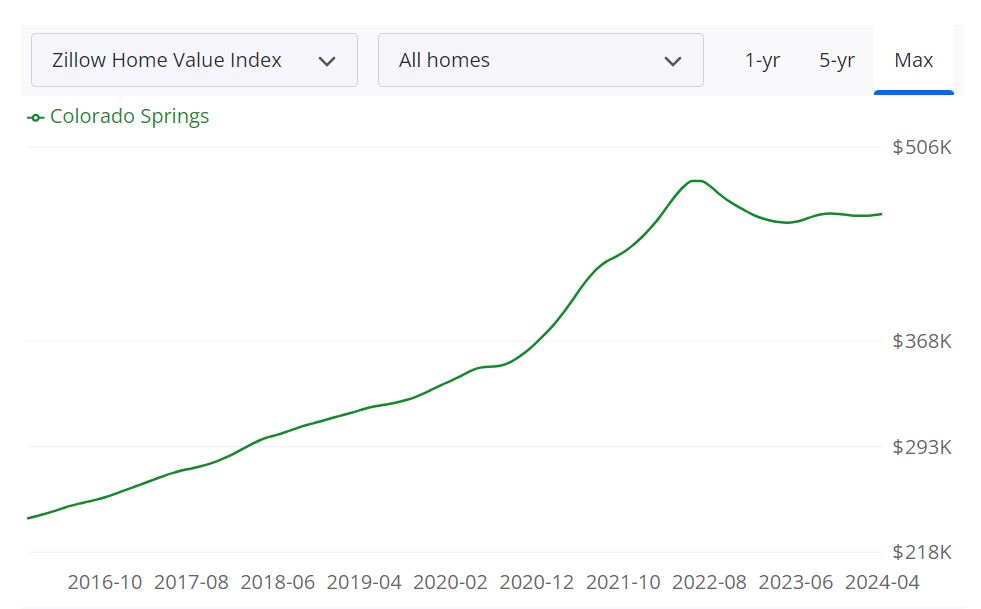The Colorado housing market has been a hot topic lately, with everyone wondering what's in store for 2024. Will the frenzy continue, or are we in for a change of pace? Despite more homes for sale, buyers are hesitant, creating an interesting dynamic in the Colorado housing market trends 2024. Let's dive in and see what's really going on.
Colorado Housing Market Trends 2024
Interest Rates and Buyer Hesitancy
One of the biggest factors influencing the Colorado housing market right now is interest rates. While they've softened over the past year, they're still higher than many buyers are comfortable with. Plus, whispers of a potential rate cut by the Federal Reserve have some folks sitting on the sidelines, waiting to see how things play out. This “wait-and-see” approach is contributing to a sense of uncertainty in the market.
Think of it this way: Imagine you're at a store, and you see a jacket you really like. But then you hear there might be a sale next week. Do you buy it now, or do you wait and see if you can get a better deal later? That's kind of what's happening in the housing market right now.
Inventory Up, Buyers Holding Back
Across Colorado, there are more homes available for sale than there were this time last year. This is especially true in the bustling Denver-metro area. Think of it like this: imagine going to a store and seeing a sale on your favorite shoes. You might be more tempted to buy when there are plenty of options, right?
The same logic applies to the housing market. More choices often lead to more competition among sellers, which can be good news for buyers. But here's the catch – many buyers are still hesitant because of those pesky interest rates.
Here's a closer look at the numbers:
- Statewide, there are 3.9 months' worth of housing inventory available. This means that, at the current pace of sales, it would take about 3.9 months to sell all the homes currently listed — Colorado Association of REALTORS®.
- In the Denver-metro area, it's 3.6 months.
These numbers are up by more than 30% compared to last year. Generally, a balanced housing market is considered to have around 6 months of inventory.
Prices Remain Stable (for Now)
Despite more homes for sale, prices haven't dropped significantly. Statewide, the median price for a single-family home is $584,000. In the Denver-metro area, it's a bit higher, at $626,779.
Here's why: even though there are more homes available, demand is still outpacing supply in many areas, especially for those in desirable locations or with sought-after features.
What Experts Are Saying About the 2024 Colorado Housing Market
I spoke to some local real estate experts to get their take on Colorado housing market trends 2024, and here's what they had to say:
- Watch for a surge in buyer activity later in the year. If interest rates drop as predicted, buyers who have been waiting on the sidelines might jump back into the market.
- Sellers need to be realistic about pricing. With more competition, homes that are overpriced are likely to sit on the market longer.
- It's still a good time to buy if you're prepared. Even though prices are holding steady, buyers have more negotiating power now than they did a year ago.
Regional Highlights: A Closer Look at Colorado's Housing Market
Colorado's housing market isn't a one-size-fits-all situation. Different areas are experiencing unique trends:
- Denver County: The condo/townhouse market is seeing some price drops as buyers grapple with rising HOA and insurance costs. Single-family homes, however, are holding their value.
- Fort Collins: Buyers are waiting for a more significant drop in interest rates before jumping in, but that pent-up demand could lead to a busy fall market.
- Colorado Springs: Inventory is up, and buyers are in a good position to negotiate.
- Boulder/Broomfield Counties: Prices are stable, but the market is waiting for a potential interest rate cut to really take off.
- Telluride: High-end sales are strong, with Telluride experiencing record-breaking sales volume.
Final Thoughts
After years of breakneck speed, the Colorado housing market is finally taking a breather. This doesn't mean we're headed for a crash, but it does mean we're moving toward a more balanced market, which is ultimately a good thing for everyone. Keep a close eye on interest rates, stay informed about local market conditions, and don't be afraid to consult with a trusted real estate professional to help you navigate the Colorado housing market trends in 2024.
Colorado Housing Market Predictions 2024-2025
Colorado's housing market is doing pretty well, with home values staying mostly the same compared to last year. This means good things for people who already own homes and shows that the market is stable overall. But, like any good detective story, there are always more details to uncover!
What's Happening Right Now?
Let's take a closer look at what's going on in the Colorado housing market:
- Prices: According to Zillow, the average price of a home in Colorado is around $546,667. However, people selling their homes are asking for a bit more, around $589,667. This difference might make buyers think twice before making an offer.
- Selling Fast: Homes are selling quickly in Colorado, usually within about 21 days. This tells us that the market is pretty active.
- Getting a Fair Price: Most homes are selling close to their asking price. This means sellers are usually getting what they want, but buyers might not have as much room to negotiate.
- Deals to be Found: Interestingly, almost half of the homes sold (44.2%) went for less than the asking price. This means there are still deals out there for buyers who are willing to look!
What About the Future Predictions?
While things seem pretty steady now, experts predict some changes in different parts of Colorado:
Big Cities:
- Denver: Prices might drop a little (-0.8%) because things are slowing down across the country. But Denver is still a cool place to live with lots of jobs!
- Colorado Springs: Similar to Denver, prices might dip slightly (-0.6%). However, Colorado Springs is still a great option because it offers a good mix of city life and affordability.
- Fort Collins: This college town might see prices drop a bit more (-1.0%) because of its younger population.
- Boulder: Prices might decrease slightly (-1.2%) because living in this beautiful city is expensive.
- Greeley: Things are expected to slow down a bit here, with prices dropping slightly (-1.1%).
Towns with Potential:
- Pueblo: This town is attracting newcomers because it's more affordable, so prices might actually go up a little (+0.3%).
- Grand Junction: This place is becoming more popular and prices might increase a bit more (+1.7%).
- Steamboat Springs: Get ready for a price jump! This vacation spot is expected to see the biggest increase (+5.7%) because it's so popular all year round.
The Bottom Line:
Colorado's housing market is holding steady, but there are some price changes coming to different areas. Whether you're buying or selling, it's always smart to do your research and talk to a real estate expert to make the best decision for you.
This graph by Zillow illustrates the growth of home values in the region over the past year, along with a forecast suggesting this trend will likely continue for the next year.

Will the Colorado Housing Market Crash?
While no one can predict the future with certainty, there are currently no indications of an imminent housing market crash in Colorado. The market has demonstrated stability and resilience, with factors such as strong demand, limited inventory, and favorable economic conditions contributing to its overall health. However, it's essential to remain vigilant and monitor key indicators to identify any emerging risks.
The forecast for the next year predicts a continued slowdown in price appreciation and sales volume, but it is still expected to remain a seller's market. One significant factor that could impact the Colorado housing market's future is the state's economy. Colorado's economy has been robust, with low unemployment rates and a thriving tech industry, attracting a large number of people to the state.
However, if the economy were to take a downturn, it could lead to a decrease in demand for homes and a subsequent drop in prices. Additionally, rising interest rates could also affect the housing market, making it more expensive for buyers to obtain mortgages and leading to a decrease in demand.
While there is always a risk of a market crash, it is unlikely to happen in the current scenario. The Colorado housing market has shown resilience to economic fluctuations in the past, and its diverse economy and job growth make it less vulnerable to sudden changes. Furthermore, the state's population growth is expected to continue, which will keep the demand for homes high.
In conclusion, the Colorado housing market has been a challenging environment for buyers in recent years, with high prices and limited inventory. While the market may be slowing down, it is still a seller's market, and prices are expected to continue appreciating, albeit at a slower pace.
Factors such as the state's robust economy and population growth suggest that the housing market is unlikely to crash in the current scenario, but rising interest rates could lead to a decrease in demand and a subsequent drop in prices. Therefore, it is essential to keep an eye on economic indicators and market trends while making any real estate decisions in Colorado.












